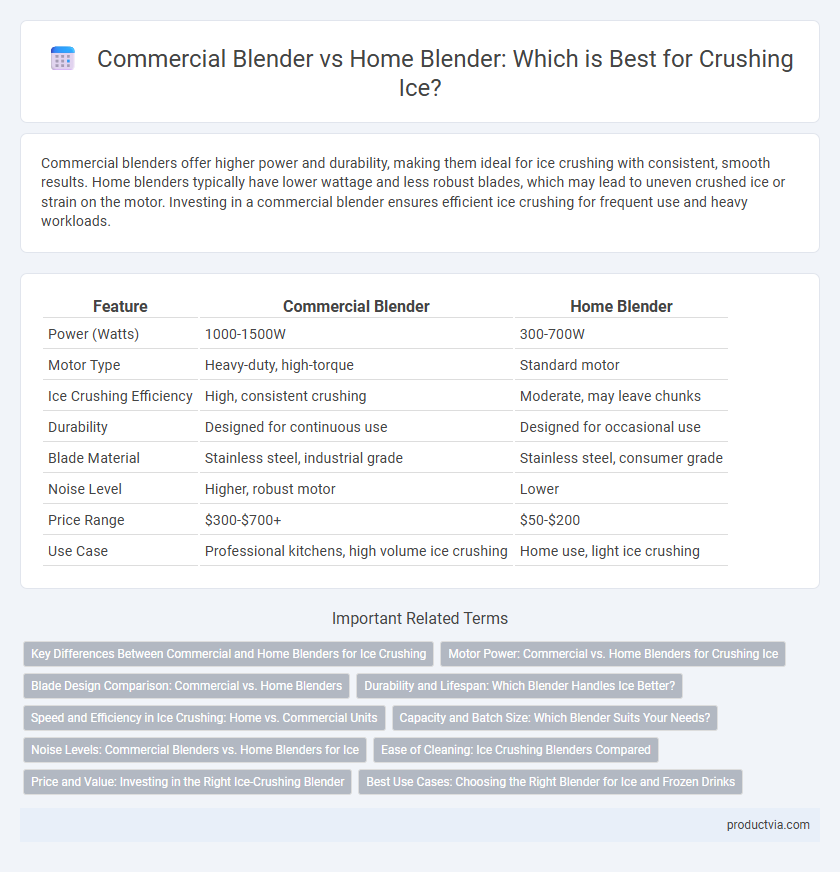Commercial blenders offer higher power and durability, making them ideal for ice crushing with consistent, smooth results. Home blenders typically have lower wattage and less robust blades, which may lead to uneven crushed ice or strain on the motor. Investing in a commercial blender ensures efficient ice crushing for frequent use and heavy workloads.
Table of Comparison
| Feature | Commercial Blender | Home Blender |
|---|---|---|
| Power (Watts) | 1000-1500W | 300-700W |
| Motor Type | Heavy-duty, high-torque | Standard motor |
| Ice Crushing Efficiency | High, consistent crushing | Moderate, may leave chunks |
| Durability | Designed for continuous use | Designed for occasional use |
| Blade Material | Stainless steel, industrial grade | Stainless steel, consumer grade |
| Noise Level | Higher, robust motor | Lower |
| Price Range | $300-$700+ | $50-$200 |
| Use Case | Professional kitchens, high volume ice crushing | Home use, light ice crushing |
Key Differences Between Commercial and Home Blenders for Ice Crushing
Commercial blenders feature more powerful motors typically ranging from 1,200 to 3,000 watts, enabling efficient ice crushing compared to home blenders that usually have motors between 300 and 700 watts. The blades in commercial blenders are made of durable stainless steel designed to withstand frequent, heavy-duty use, while home blender blades may dull faster under similar stress. Commercial blenders also often include advanced cooling systems to prevent overheating during continuous operation, a feature less common in home models.
Motor Power: Commercial vs. Home Blenders for Crushing Ice
Commercial blenders typically feature motors ranging from 1,200 to over 3,000 watts, delivering superior torque and durability necessary for efficiently crushing ice without overheating. Home blenders usually have lower motor power, between 300 and 600 watts, which can struggle with dense ice and may overheat with prolonged use. Higher motor power in commercial blenders ensures consistent, smooth ice crushing suitable for high-volume or professional environments.
Blade Design Comparison: Commercial vs. Home Blenders
Commercial blenders feature heavy-duty, stainless steel blades with multiple cutting edges designed for high-speed ice crushing and consistent durability under continuous use. Home blenders typically use thinner, fewer blades that may struggle with dense ice, resulting in uneven crushing and increased wear over time. The blade geometry and thickness in commercial models optimize shear force and reduce motor strain, making them more efficient and longer-lasting for ice blending tasks.
Durability and Lifespan: Which Blender Handles Ice Better?
Commercial blenders, built with robust motors and heavy-duty stainless steel blades, offer superior durability and longer lifespan when handling ice compared to home blenders. Designed for frequent, intense use, commercial blenders resist wear and blade dulling, maintaining consistent crushing performance. Home blenders may struggle with ice, often resulting in shorter motor life and blade damage under constant heavy use.
Speed and Efficiency in Ice Crushing: Home vs. Commercial Units
Commercial blenders feature powerful motors exceeding 3 HP that enable rapid ice crushing in seconds, ensuring high efficiency for continuous heavy use. Home blenders typically have motors under 1.5 HP, resulting in slower ice crushing and less consistent texture. The advanced blade design and robust drive systems in commercial units provide superior speed and durability compared to consumer-grade models.
Capacity and Batch Size: Which Blender Suits Your Needs?
Commercial blenders offer significantly larger capacity and batch size, making them ideal for heavy-duty ice crushing in restaurants or bars where large volumes are processed continuously. Home blenders typically have smaller containers, ranging from 40 to 70 ounces, suitable for casual use and single servings of crushed ice. Choosing a blender depends on your specific volume requirements, with commercial models providing efficiency for bulk tasks while home blenders serve everyday personal needs effectively.
Noise Levels: Commercial Blenders vs. Home Blenders for Ice
Commercial blenders typically operate at higher decibel levels, often exceeding 90 dB during ice crushing, due to more powerful motors and robust blades designed for continuous heavy use. Home blenders generally produce lower noise levels, averaging around 70-80 dB, suitable for occasional ice crushing but less effective for prolonged heavy-duty tasks. Noise insulation features and motor housing design significantly influence the sound output, making commercial blenders noisier but more efficient for demanding ice crushing applications.
Ease of Cleaning: Ice Crushing Blenders Compared
Commercial blenders designed for ice crushing typically feature detachable, dishwasher-safe parts that make cleaning faster and more efficient compared to home blenders. Heavy-duty materials and sealed components in commercial models reduce residue buildup, enhancing hygiene and maintenance ease. Home blenders often require manual disassembly and thorough hand washing, increasing cleaning time and effort after crushing ice.
Price and Value: Investing in the Right Ice-Crushing Blender
Commercial blenders designed for ice crushing typically feature more durable motors and reinforced blades, offering higher performance but at a price range of $300 to $700. Home blenders usually cost between $50 and $200, providing sufficient ice-crushing capabilities for occasional use but with less longevity. Investing in a commercial blender delivers better value for frequent ice crushing due to its efficiency and durability, while home blenders suit budget-conscious users with light to moderate use.
Best Use Cases: Choosing the Right Blender for Ice and Frozen Drinks
Commercial blenders excel at crushing ice quickly and consistently, making them ideal for high-volume settings like restaurants and bars where efficiency and durability are essential. Home blenders are suitable for occasional ice crushing in smoothies and frozen drinks, offering sufficient power and versatility for everyday use without the industrial-grade cost. Selecting the right blender depends on the frequency of use, volume of ice required, and desired drink quality.
Commercial blender vs Home blender for ice crushing Infographic

 productvia.com
productvia.com